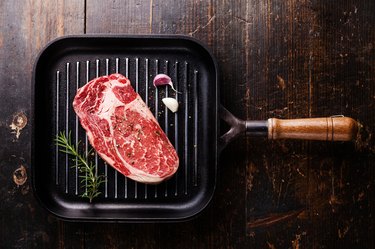
A Pittsburgh-rare steak is one that has been cooked quickly, at a very hot temperature. The cooking method results in meat with a charred crust and a rare interior. This classic American dish may not be for everyone, but is has a devoted following.
Tip
To cook a Pittsburgh-style steak, apply butter and seasonings to your meat. Cook on a grill or char-broiler, on the hottest temperature, for 60 to 90 seconds per side.
Video of the Day
Pittsburgh-Style Steak
Ed Wiley III, owner and chef of The Prime Smokehouse in Rocky Mount, North Carolina, shares the recipe below and answers questions for LIVESTRONG.com.
Video of the Day
Things You'll Need
Steak
Softened butter
Thyme
Salt
Black pepper
Paprika
Granulated garlic
Instructions:
- Turn your char-broiler or grill on to the hottest setting, and allow it to heat for at least five minutes before putting your steak on it.
- Mix softened, unsalted butter with thyme. Pat your steak dry, and and then brush the herb butter on all sides of the steak.
- Create a dry rub, using coarse salt, cracked black pepper, paprika and a pinch of granulated garlic. (The added ingredients, rather than merely salt and pepper, add another level of flavor to the crust.)
- Lay the meat on the grill, allowing the flames to rise violently around it. Apply more butter to the top of the steak and flip it. The process should take 60 to 90 seconds per side. The important thing is to make sure you have a nice dark crust on all sides, while the middle remains red and cool.
About Pittsburgh-Rare Steaks
What's a blue steak? It's a term for a steak cooked very rare. According to Wiley, a black and blue steak refers to meat that has been cooked black on the outside but remains "blue," or raw, on the interior. "It's another name for Pittsburgh-style steak, because the dish reportedly originated in that city," he says.
What type of meat is best for a Pittsburgh-rare steak? "Start with a quality piece of meat. Filet mignon is an excellent cut, but New York strip, and even the fattier ribeye, works well. The key to preparing this dish is to create a nice, flavorful crust without burning and drying out the meat," Wiley states.
People often want to know the best way to order a steak. This is a matter of personal preference, but most chefs recommend medium-rare steak, since it has good flavor without sacrificing tenderness, notes Taste of Home. Wiley's personal favorite is medium-rare, but he's not surprised by the numerous customer requests for black-and-blue style steak at his restaurant.
Red-Meat Eating Guidelines
Choose lean cuts of red meat, and eat them in moderation, because they have some negative health effects. Consuming a diet rich in red meat is linked to a higher risk of heart attacks and strokes, states the U.S. National Library of Medicine. In addition, it's associated with an increased likelihood of rectal and colon cancer, and possibly other malignancies such as pancreatic and prostate cancer, reports the National Cancer Institute.
The World Cancer Research Fund advocates limiting red meat to no more than three servings per week. One serving of meat is about 2 to 3 ounces, which is approximately the size of a deck of playing cards, says the American Heart Association. Before cooking red meat, trim off as much fat as possible. Also, opt for healthier preparation methods, such as baking, broiling and roasting.
It's best to get protein from other foods like poultry and fish, as well as plant sources like beans and nuts. A 1-cup serving of peas, lentils or beans can replace a 2-ounce serving of meat, the AHA advises.
- The Prime Smokehouse: "Homepage"
- Taste of Home: "The Surprising Thing You Should Avoid Ordering at a Steakhouse"
- U.S. National Library of Medicine: "Red Meat and the Risk of Heart Disease"
- National Cancer Institute: "Red Meat and Processed Meat Consumption"
- World Cancer Research Fund: "Limit Red and Processed Meat"
- American Heart Association: "Meat, Poultry, and Fish: Picking Healthy Proteins"